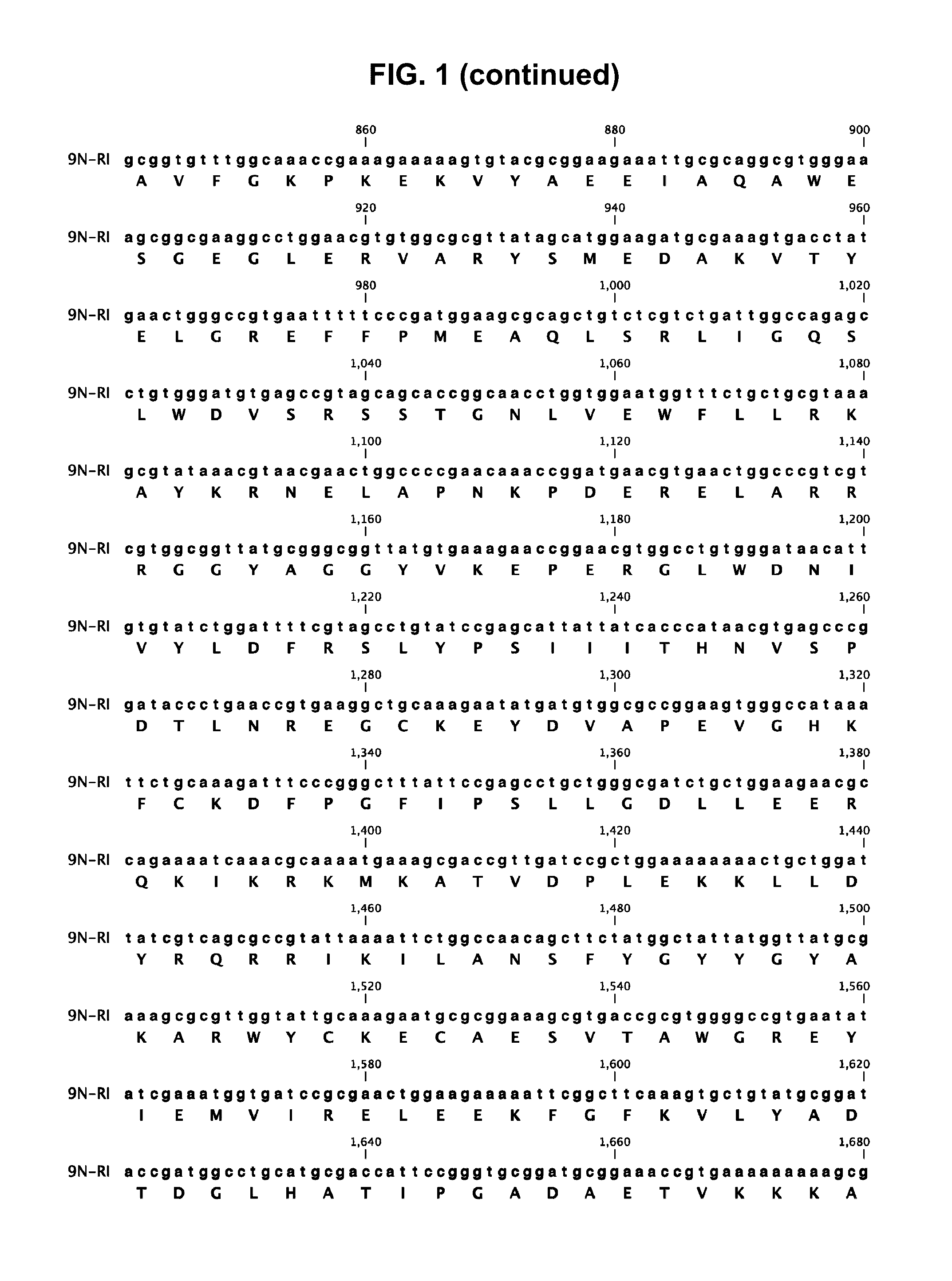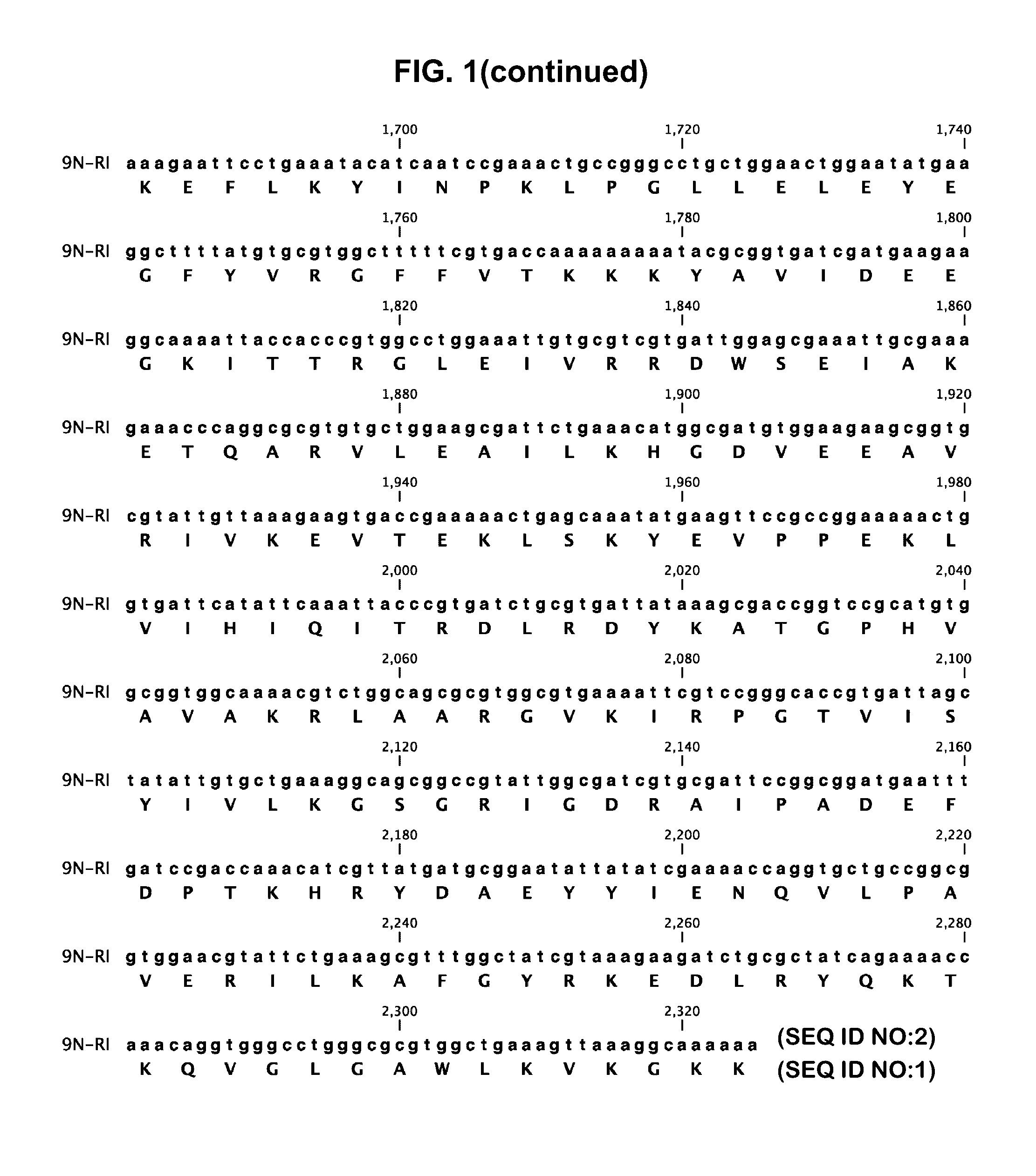Modified polymerases for replication of threose nucleic acids
a technology of threose nucleic acids and polymerases, which is applied in the field of synthetic genetics, can solve problems such as incorrect copying of messages, and achieve the effects of improving tna transcription fidelity, high fidelity, and reducing polymerase fidelity
- Summary
- Abstract
- Description
- Claims
- Application Information
AI Technical Summary
Benefits of technology
Problems solved by technology
Method used
Image
Examples
example 1
Generation of a Mutated DNA Polymerase for TNA Synthesis
[0052]In this example, we show how to prepare the mutated DNA polymerase for TNA synthesis. FIG. 1 depicts the nucleotide and amino acid sequence of 9NRI polymerase. DNA template and its corresponding primer are heated in Thermopol buffer for 5 min at 95 C. The reaction is cooled for 10 min at 4 C to promote the formation of primer-template complexes. After the 10 minute incubation, the enzyme and manganese are combined and added to the primer template complex. The reaction is then brought to 55 C. The reaction is initiated by adding tNTPs to a final concentration of 100 uM each and then incubated for the desired amount of time.
example 2
Identification of 9NRI
[0053]In this example, we describe how we identified and characterized 9NRI and its mutations D141A, E143A, A485R, and E664I. FIG. 2 depicts TNA transcription reactions of 9NRI polymerase in the presence and absence of manganese. Four different templates containing an increase number of sequential G nucleobases were combined with radiolabeled primer, tNTPs, and enzyme in the presence or absence of manganese ions. The reactions were incubated for three hours when in presence of Mn2+ and 25 hrs when in the absence of Mn2+ at 55 C. The TNA transcription reactions were analyzed by denaturing urea polyacrylamide gel electrophoresis. The gels were then imaged on a phosphorimaging screen.
[0054]Variants were generated for all 20 amino acids at positions 485 and 664 independently by site directed mutagenesis. Each variant was tested in a TNA transcription reaction and analyzed by polyacrylamide gel electrophoresis. The most active variants at positions 485 and 664 were ...
example 3
Characterization of 9NRI
[0055]In this example, we describe the characterization of the 9NRI enzyme. 9NRI is capable of generating a significant amount of full length TNA in the absence of manganese. Previous enzymes were unable to generate any material. Additionally, 9NRI is capable of transcribing through sequences with higher numbers of sequential G nucleobases.
PUM
| Property | Measurement | Unit |
|---|---|---|
| time | aaaaa | aaaaa |
| temperature | aaaaa | aaaaa |
| temperature | aaaaa | aaaaa |
Abstract
Description
Claims
Application Information
 Login to View More
Login to View More - R&D
- Intellectual Property
- Life Sciences
- Materials
- Tech Scout
- Unparalleled Data Quality
- Higher Quality Content
- 60% Fewer Hallucinations
Browse by: Latest US Patents, China's latest patents, Technical Efficacy Thesaurus, Application Domain, Technology Topic, Popular Technical Reports.
© 2025 PatSnap. All rights reserved.Legal|Privacy policy|Modern Slavery Act Transparency Statement|Sitemap|About US| Contact US: help@patsnap.com



